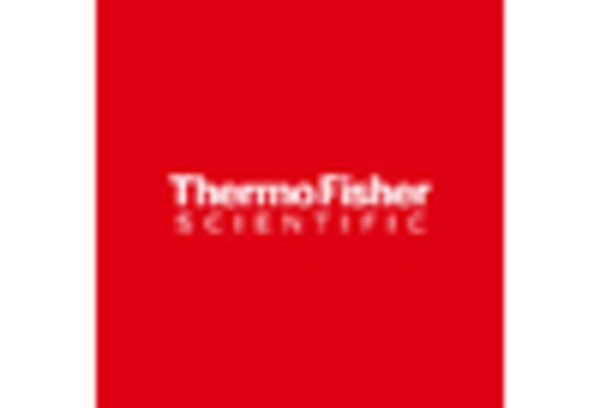Rising Incidence of Antibiotic Resistance
The increasing prevalence of antibiotic resistance is a critical driver for the Antibiotic Susceptibility Testing Market. As bacteria evolve and develop resistance to commonly used antibiotics, healthcare providers are compelled to adopt susceptibility testing to ensure effective treatment. According to recent data, antibiotic resistance contributes to approximately 700,000 deaths annually worldwide, a figure that could rise to 10 million by 2050 if left unaddressed. This alarming trend underscores the necessity for accurate testing methods, propelling the demand for advanced susceptibility testing solutions. Consequently, the market is witnessing a surge in investments aimed at developing innovative testing technologies that can provide rapid and reliable results, thereby enhancing patient outcomes and combating the threat of resistant infections.
Technological Innovations in Testing Methods
Technological advancements play a pivotal role in shaping the Antibiotic Susceptibility Testing Market. Innovations such as automated systems, molecular diagnostics, and rapid testing methods are transforming the landscape of susceptibility testing. For instance, the introduction of next-generation sequencing and microfluidics has enabled faster and more precise identification of pathogens and their resistance profiles. The market is projected to grow significantly, with estimates suggesting a compound annual growth rate of over 7% in the coming years. These advancements not only improve the accuracy of test results but also reduce the time required for diagnosis, allowing for timely and appropriate antibiotic therapy. As healthcare systems increasingly prioritize efficiency and patient safety, the demand for cutting-edge testing technologies is expected to rise, further driving market growth.
Increased Focus on Infection Control Practices
The heightened emphasis on infection control practices within healthcare settings is a notable driver for the Antibiotic Susceptibility Testing Market. Hospitals and clinics are increasingly implementing stringent infection prevention protocols to mitigate the spread of resistant bacteria. This focus is reflected in the growing adoption of susceptibility testing as a standard practice in clinical microbiology laboratories. Data indicates that facilities employing robust infection control measures experience lower rates of healthcare-associated infections, which in turn reduces the burden on healthcare systems. As a result, the demand for reliable susceptibility testing solutions is expected to escalate, as healthcare providers seek to enhance their infection control strategies and ensure optimal patient care. This trend is likely to foster collaborations between testing solution providers and healthcare institutions, further propelling market expansion.
Rising Awareness Among Healthcare Professionals
The growing awareness among healthcare professionals regarding the importance of antibiotic susceptibility testing is significantly influencing the Antibiotic Susceptibility Testing Market. Educational initiatives and training programs aimed at clinicians and microbiologists are fostering a deeper understanding of the implications of antibiotic resistance and the necessity for accurate testing. As healthcare providers become more informed about the benefits of susceptibility testing, they are more likely to incorporate these practices into their clinical decision-making processes. This shift is expected to drive market growth, as increased utilization of testing services leads to improved patient outcomes and reduced healthcare costs associated with ineffective antibiotic treatments. Furthermore, the collaboration between medical associations and testing companies to promote best practices is likely to enhance the visibility and adoption of susceptibility testing in various healthcare settings.
Regulatory Support for Antibiotic Stewardship Programs
Regulatory bodies are increasingly advocating for antibiotic stewardship programs, which is a significant driver for the Antibiotic Susceptibility Testing Market. These programs aim to optimize the use of antibiotics and combat the rise of resistance through appropriate prescribing practices. Governments and health organizations are implementing guidelines that emphasize the necessity of susceptibility testing before initiating antibiotic therapy. This regulatory support is fostering a conducive environment for the growth of the testing market, as healthcare facilities are encouraged to adopt testing protocols to comply with these guidelines. The market is likely to benefit from increased funding and resources allocated to support antibiotic stewardship initiatives, which may include the integration of advanced susceptibility testing technologies. As a result, the alignment of regulatory frameworks with market needs is expected to enhance the overall effectiveness of antibiotic use and improve patient care.


















Leave a Comment